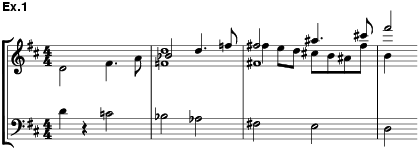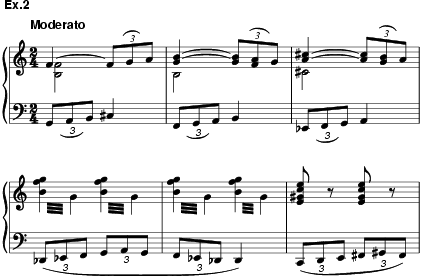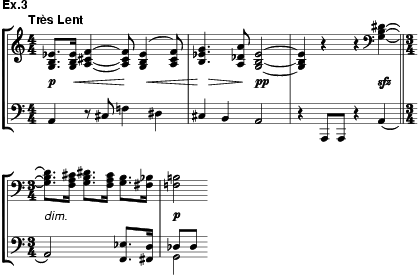A
scale that divides the octave into six equal-tempered whole tones: C–D–E–F![]() –G
–G![]() –A
–A![]() (=B
(=B![]() )–C or its sole transposition, D
)–C or its sole transposition, D![]() –E
–E![]() –F–G–A–B(=C
–F–G–A–B(=C![]() )–D
)–D![]() . Since all the intervals between adjacent degrees are
the same, the scale is tonally unstable, that is, a centre can be formed only
by emphasizing one of its notes to give it artificial prominence. Moreover, it
lacks the fundamental harmonic and melodic relationships of major–minor
tonality, namely those of the dominant (perfect 5th) and the leading note
(minor 2nd).
. Since all the intervals between adjacent degrees are
the same, the scale is tonally unstable, that is, a centre can be formed only
by emphasizing one of its notes to give it artificial prominence. Moreover, it
lacks the fundamental harmonic and melodic relationships of major–minor
tonality, namely those of the dominant (perfect 5th) and the leading note
(minor 2nd).
Whole-tone melodic passages within the diatonic system were explored fairly extensively by Russian composers in the 19th century. A passage near the end of Glinka’s overture to Ruslan and Lyudmila (1842), given in ex.1, shows how a whole-tone scale in the bass can be harmonized by a series of transitions, all keeping within the bounds of traditional tonality. Dargomïzhsky, in The Stone Guest (c1866–9), came much nearer to using it as an autonomous system, generating contoured melodic lines as well as harmonies (for instance, in the passage from Act 3 quoted in ex.2). But it was in the works of the French Impressionists, particularly Debussy, that it was first used in opposition to the major–minor system, as a means of suspending tonality. The pervasion of the whole-tone scale in Debussy’s piano prelude Voiles (from book 1, 1910) is exceptional, though it figures significantly in the harmony of many of his earlier works, including Pelléas et Mélisande (1902; see ex.3, from Act 4 scene ii) and La mer (1905). It was also an important transitional element in the development of an atonal idiom in Germany in the decade before World War I. Messiaen classified it as the first Mode of limited transposition.



H.K. ANDREWS/R